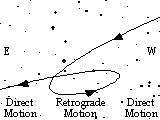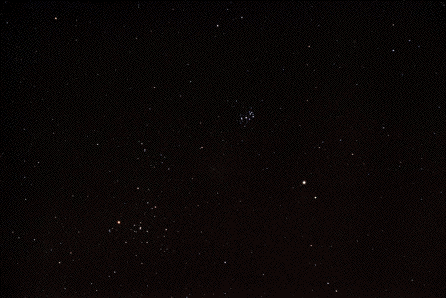Direct and Retrograde Motion
- In addition to the stars, the Sun, and the Moon, there are several other objects in the sky which are easily visible at night.
From the ancient perspective, a planet is a point of light in the sky that moves relative to the stars, much as the Sun and Moon do.
The name comes from the Greek for "wanderer".
- With the naked eye, one can see five planets: Mercury, Venus, Mars,Jupiter, and Saturn.
Extra: the Sun, Moon, and planets are associated with ancient gods, and their number is the basis of our seven-day week.
- Like the Sun and the Moon, the planets all move near the ecliptic, never being more than a few degrees away.
In the photo at the right, you can see (from top to bottom) Saturn, Venus, Jupiter, and Mercury in alignment with the recently set Sun.
- The planets move slowly enough that their positions change only slightly from night to night.
They therefore rise in the east and set in the west as part of the sky's diurnal motion.

- Relative to the stars, however, the planets generally move from west to east , like the Sun and Moon.
Their speeds vary, but Mercury is the fastest, followed by Venus, Mars, Jupiter, and then Saturn, the slowest.
This motion is called direct motion.
- What distinguishes the planets from the Sun and Moon is that they will also sometimes reverse their motion, travelling from east to west relative to the stars.
This reverse motion is known as retrograde motion.
Retrograde motion can last from weeks (Mercury) to months (Saturn).
- The image below displays the actual retrograde motion of Jupiter (brighter) and Saturn (dimmer) over eleven months:



No comments:
Post a Comment